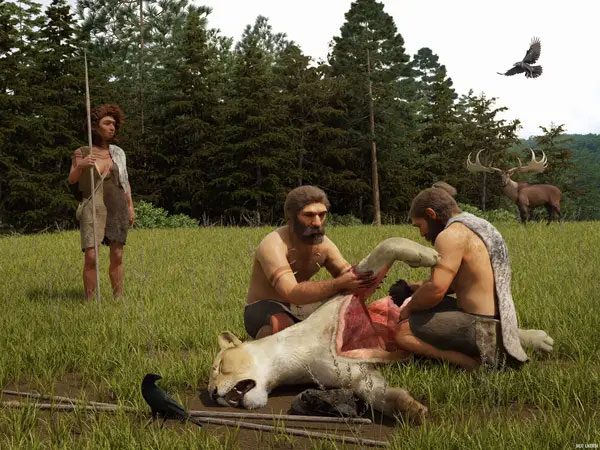Previously, we believed that lions were at the top of the prehistoric food chain. However, recent discoveries indicate that prehistoric humans actively hunted lions for food and their hides.
After analyzing the bones of the European cave lion (scientific name: Panthera spelaea – an extinct subspecies of lion), scientists have recently uncovered the earliest evidence of Neanderthals hunting cave lions, as well as their close relatives, modern humans, using lion skins for cultural purposes.
Researchers have identified how Neanderthals killed a cave lion. Fossilized bones discovered in Germany reveal that Neanderthals could sneak up behind the lion while it was resting and stab it in the abdomen.
The injury found on one of the lion’s ribs indicates that the weapon penetrated vital organs before embedding itself in the animal’s chest. This lion hunt is estimated to have occurred around 48,000 years ago, during the Middle Paleolithic period (30,000 to 300,000 years ago).

Neanderthals hunting cave lions. (Illustrative image).
Previous studies of nearly complete cave lion skeletons—excavated in Siegsdorf, southern Germany, in 1985—also revealed cut marks on some bones. This suggests that Neanderthals had consumed the lion. However, it was previously unclear whether our human relatives hunted lions or simply processed the remains of animals that had died earlier.
Now, everything has become clear. In a new study published on Thursday (October 12, 2023), in the journal Scientific Reports, the scientists wrote: “The new findings from Siegsdorf provide a unique picture of human life at the end of the Middle Paleolithic period. Our analysis demonstrates for the first time that Neanderthals were capable of actively hunting cave lions with simple wooden spears.”
Neanderthals were an extinct branch of hominins that appeared around 400,000 years ago and disappeared nearly 40,000 years ago. They are the closest known relatives of modern humans and had genetic interbreeding with us (Homo sapiens). According to research, Neanderthals were skilled hunters who actively preyed on large carnivores not only for food but also for ceremonial purposes.
The study revealed that the stab wounds on cave lion bones were angled and resembled injuries found on the vertebrae of deer, believed to have been inflicted by Neanderthal wooden spears. The absence of tooth marks on the lion’s rib and the shape of the stab wound ruled out the possibility of another predator having killed it.
After the Neanderthal hunters took down the cave lion, they likely skinned it, cut the meat and organs, and discarded the remaining parts. The research team stated that the cut marks indicate it was butchered at the kill site and added that the lion may have been in critical condition at the time of death.
The new study also found what could be the earliest evidence of Neanderthals using cave lion hides for clothing or bedding.
Researchers found cut marks on the toe bones of three cave lions dating back 45,000 to 55,000 years, suggesting they had been skinned, with their claws preserved. These skeletons—excavated in 2019 from Einhornhohle in central Germany—were unpolished, intact, and showed no special characteristics related to bones used for pendants or clothing.
This led researchers to assert: “This rare evidence indicates that humans in the Paleolithic era could carefully process the pelts of large carnivores to preserve aesthetic features like claws.”
They further noted that both discoveries “provide new information about the complexity of Neanderthal behavior.”


















































